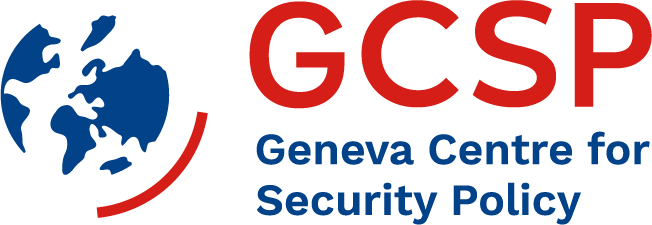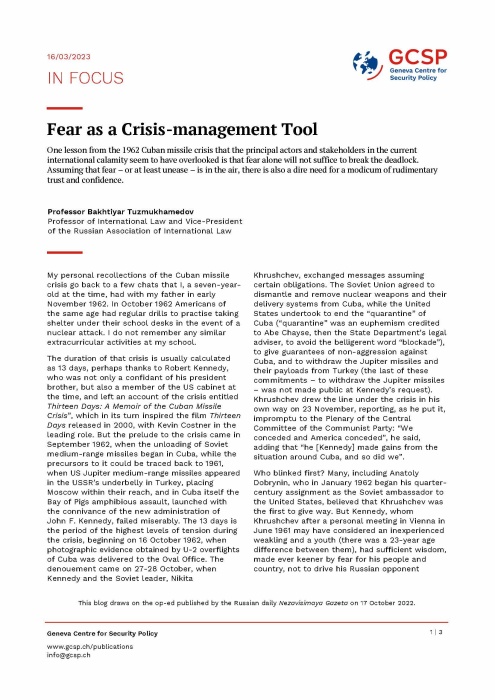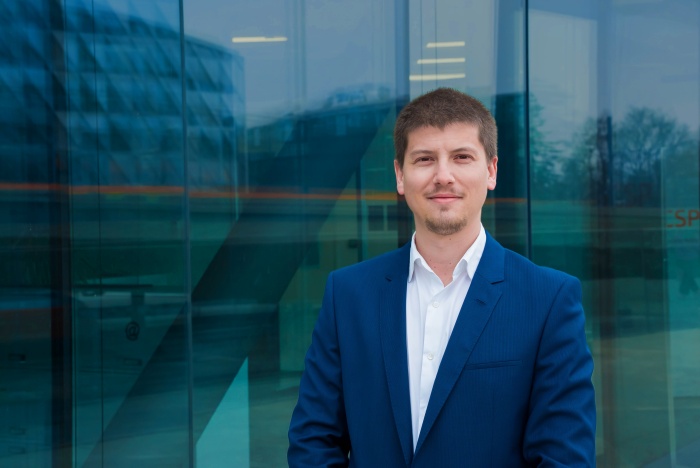Fear as a Crisis-management Tool
One lesson from the 1962 Cuban missile crisis that the principal actors and stakeholders in the current international calamity seem to have overlooked is that fear alone will not suffice to break the deadlock. Assuming that fear – or at least unease – is in the air, there is also a dire need for a modicum of rudimentary trust and confidence.
My personal recollections of the Cuban missile crisis go back to a few chats that I, a seven-year-old at the time, had with my father in early November 1962. In October 1962 Americans of the same age had regular drills to practise taking shelter under their school desks in the event of a nuclear attack. I do not remember any similar extracurricular activities at my school.
The duration of that crisis is usually calculated as 13 days, perhaps thanks to Robert Kennedy, who was not only a confidant of his president brother, but also a member of the US cabinet at the time, and left an account of the crisis entitled Thirteen Days: A Memoir of the Cuban Missile Crisis”, which in its turn inspired the film Thirteen Days released in 2000, with Kevin Costner in the leading role. But the prelude to the crisis came in September 1962, when the unloading of Soviet medium-range missiles began in Cuba, while the precursors to it could be traced back to 1961, when US Jupiter medium-range missiles appeared in the USSR’s underbelly in Turkey, placing Moscow within their reach, and in Cuba itself the Bay of Pigs amphibious assault, launched with the connivance of the new administration of John F. Kennedy, failed miserably. The 13 days is the period of the highest levels of tension during the crisis, beginning on 16 October 1962, when photographic evidence obtained by U-2 overflights of Cuba was delivered to the Oval Office. The denouement came on 27-28 October, when Kennedy and the Soviet leader, Nikita Khrushchev, exchanged messages assuming certain obligations. The Soviet Union agreed to dismantle and remove nuclear weapons and their delivery systems from Cuba, while the United States undertook to end the “quarantine” of Cuba (“quarantine” was an euphemism credited to Abe Chayse, then the State Department’s legal adviser, to avoid the belligerent word “blockade”), to give guarantees of non-aggression against Cuba, and to withdraw the Jupiter missiles and their payloads from Turkey (the last of these commitments – to withdraw the Jupiter missiles – was not made public at Kennedy’s request). Khrushchev drew the line under the crisis in his own way on 23 November, reporting, as he put it, impromptu to the Plenary of the Central Committee of the Communist Party: “We conceded and America conceded”, he said, adding that “he [Kennedy] made gains from the situation around Cuba, and so did we”.
Who blinked first? Many, including Anatoly Dobrynin, who in January 1962 began his quarter-century assignment as the Soviet ambassador to the United States, believed that Khrushchev was the first to give way. But Kennedy, whom Khrushchev after a personal meeting in Vienna in June 1961 may have considered an inexperienced weakling and a youth (there was a 23-year age difference between them), had sufficient wisdom, made ever keener by fear for his people and country, not to drive his Russian opponent into a corner and push him into desperate recklessness.
From the point of view of international practice, the arrangement reached was an agreement in the form of an exchange of letters. It was not a fully-fledged treaty, because there was no time to conclude one, while the fear of getting too close to the brink spurred the negotiations. International law in its normative incarnation is a conservative-reactive institution, and a dose of fright is sometimes needed for its reactive function to kick off quickly. The catastrophic oil spills after maritime accidents involving super-tankers or the Chernobyl nuclear cataclysm are paradigmatic examples of how such an incentive works. Conversely, the cholera plague in the middle of the 19th century or the recent COVID-19 pandemic did not seem to carry a sufficient charge of panic to start the process of rapid crisis resolution.
The bout of fear in the aftermath of the Cuban missile crisis had a multifaceted effect. It high-lighted the importance of personal confidential contacts in international relations, as established between Dobrynin and Robert Kennedy, as well as other less prominent characters, but also damaged the nascent relationship between John Kennedy and Khrushchev. The former believed he had been deceived by a negotiating partner who, even when irrefutable evidence was presented, denied the delivery of offensive weapons to Cuba. The latter did not trust the former, especially after the Bay of Pigs, although at some point he was ready to accept an unprecedented measure – the presence of US inspectors on Soviet territory in the immediate vicinity of nuclear test sites.
However, as both Dobrynin and the current Russian ambassador to the United States, Anatoly Antonov, wrote in their respective books, the crisis boosted Soviet Union-US negotiation processes, initially resulting in the bilateral “Hot Line” agreement and the multilateral Partial Test Ban Treaty, both concluded in 1963, and later other treaties on the practical limitation and reduction of arms stocks and related
“confidence-building measures”. Who knows how the current hemispheric crisis would have played out if the United States had not withdrawn from such an important confidence-building measure as the Open Skies Treaty, which made Russia’s continued participation pointless?
Incidentally, ever since its inception in the well-established combination term “confidence-building measures”, “confidence” has been trans-lated into Russian as “doveriye”, which in turn ought to be translated into English as “trust”.
It can be said that trust is the essential quality of any constructive relationship between people, whether they are ordinary citizens or international negotiators. Trust had developed between Soviet and US ambassadors Yuli Kvitsinsky and Paul Nitze, respectively, during the negotiations that took place in 1982 against the backdrop of the crisis over medium-range missiles in Europe (in light of the age difference of the Russian and US leaders during the Cuban missile crisis and its possible effects, it is worth noting that Kvitsinsky was 29 years younger than Nitze). As a result, they departed from the instructions they had been given by their respective governments and, guided by common sense and their understanding of their respective countries’ interests, worked out a compromise, but in the absence of trust and confidence at the highest levels of government, this was rejected in both capitals. Ralph Earle II, who led the US delegation at the SALT-2 negotiations and later advised the directors and actors of the play A Walk in the Woods based on the Kvitsinsky-Nitze episode, told me about the painstaking trust-building process he went through with his counterpart Vladimir Semyonov and other Soviet partners. I witnessed the comradely relations between retired ambassadors Oleg Khlestov and Stanley Rezor, who once headed, respectively, the Soviet and US delegations at the Vienna talks on the mutual reductions of forces and armaments in Central Europe, and the friendly interaction between ambassadors Roland Timerbaev and George Bunn, who made a significant contribution to the drafting and conclusion of the Treaty on the Non-Proliferation of Nuclear Weapons.
How can the loss of the remnants of confidence and trust still existing in the international arena be prevented and step back taken from the abyss that could result from the ongoing crisis? The problem is that, unlike in 1962, it has become chronic and, for lack of a better word, habitual. As Darel Kimball of the Arms Control Association observed, “Luckily, nuclear weapons have not been used in combat since the attacks on Hiroshima and Nagasaki. But someday, our collective luck is certain to run out”, opening the flood gates to, in the words of UN Secretary-General António Guterres, “a nuclear war that could start by accident or design”. In this regard, scant solace may be found in the “Joint Statement of the Leaders of the Five Nuclear-Weapon States on Preventing War and Nuclear Arms Races” of 3 January 2022, in which these leaders opined that “a nuclear war cannot be won and must never be fought”.
A grim alternative to a peaceful resolution of the current crisis is offered in Nevil Shute's 1957 novel On the Beach, which, along with depicting individual human stories, predicted the consequences of the uncontrolled spread of nuclear weapons across an unconfident and distrustful world and their use, whether accidental or deliberate, provoked by adventurers from not-so-major states.
This blog draws on the op-ed published by the Russian daily Nezavisimaya Gazeta on 17 October 2022.
Disclaimer: The views, information and opinions expressed in this publication are the author’s/authors’ own and do not necessarily reflect those of the GCSP or the members of its Foundation Council. The GCSP is not responsible for the accuracy of the information.


